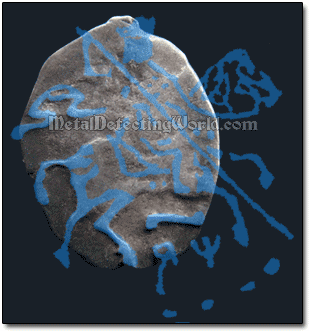How To Identify and Interpret Cyrillic Dates on Russian Coins of Peter I The Great
Helpful Tutorial for Coin Collecting Beginner, page 3
Part 2: Locate Cyrillic Numeral Dates on Coins of Peter I and Identify Symbols in a Date
If you have found the Cyrillic numeral date on your coin, and determined all letters and symbols comprising it, look the numeral up in the Conversion Table on page 5.
If you are unable to locate or decipher the numeral, read the following steps that may help you get the job done.
It is assumed that you have determined that your specimen, either a silver wire kopeck (my tutorial on Identification of Russian Wire Money will be posted upon its completion) or a disk-shaped coin, belong to the reigning period of Peter I The Great.
To identify and interpret the coin's numeral, you should:
1) Find the numeral date on the coin.
If you see an Arabic numeral, you know that that is a DATE, and you do not need this tutorial.
1-1. SILVER WIRE KOPECKS:
On silver wire coins, the numeral is located on the coin's OBVERSE and under the image of a horseman holding a spear, and the titlo sign is placed above the numeral.
If you do not see Ψ on a silver wire coin, and the numeral date consists of only two or three symbols, this means that the coin was minted before 1700 (more details below), and you should look the numeral up in the Date-Conversion Table on page 5.
Often the numeral is missing or only a fraction of it is visible on silver hammered kopecks due to displacement of numerals on coins. This is shown on illustration below. The major cause of design displacement on Peter's wire kopecks were the "oversized" coin designs themselves - they were larger than the coins.
By the end of the 17th century, the size of wire kopecks had been reduced to its critical minimum due to debasement of coins. But the mint engravers were unable to make designs any smaller, considering an amount of details, to fit inside a tiny (9mm x 7mm) area. So during the hammer striking, the dates, along with other elements of the obverse design, would just "missed" the coins for the most part.
Example of Oversized Obverse Design of 1700 Silver Wire Kopeck

Another challenging case for a coin collector is when the coin is just worn out. And if one do not see any legible details of the obverse design, one might need to consult the wire-coin catalogue for determining the date of the coin through identification of its reverse design. This is what I had to do to date the coin shown above. At least, I had the titlo sign and some of the image details visible, so I could see how they are positioned against each other.
1-2. ROUND SILVER and COPPER COINS:
The numeral dates are always present on the round silver and copper coins of the period, provided the coins are not worn out. You should look for the titlo sign, a "thousands" sign, or both. Depending on the coin design, the Cyrillic numeral can be located either on the coin's obverse or reverse.
Helpful tip: you can quickly find the numeral among other inscriptions and legends on a coin if you look for the Psi letter - Ψ, which indicates 700. As all round silver and copper coins of Peter The Great were minted after 1700, the numeral "Ψ" is supposed to be present in all date numerals on these coins.
Back to Detect Hammereds
E-Trac and CTX-3030 Programs for Hammies